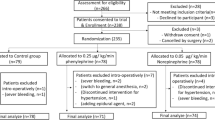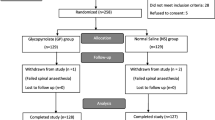Abstract
Purpose
In healthy pregnant women undergoing Cesarean section, treatment of post-spinal hypotension (PSH) with phenylephrine is reportedly more efficacious than ephedrine in preventing a decline in umbilical artery pH (UApH), which is an indicator of fetal acidosis. However, phenylephrine has the potential to reduce placental blood flow and consequently decrease UApH in women who develop hypertensive disorders of pregnancy (HDP), due to decreased cardiac function and placental vascular abnormalities. We aimed to verify the association between decreased UApH and phenylephrine administered before delivery to treat PSH in women with HDP.
Methods
This single-center retrospective cohort study was conducted between April 2008 and October 2016 by assessing the records of pregnant women with confirmed or suspected HDP who underwent Cesarean section under spinal anesthesia. The association between phenylephrine and the primary endpoint of decreased UApH was investigated using logistic regression analysis and propensity score matching.
Results
In the original cohort of 107 pregnant women with HDP, neither univariate nor multivariate analysis indicated a significant association between phenylephrine treatment and decreased UApH [crude odds ratio (OR) = 2.26; 95% confidence interval (CI) 0.75–6.77; P = 0.14], (adjusted OR = 1.80; 95% CI 0.55–5.93; P = 0.33). Thirty patients each who were not treated with phenylephrine (control group) and were treated with phenylephrine (phenylephrine group) were matched by propensity score analysis. UApH [median (interquartile range)] was not significantly different between control and phenylephrine groups [7.30 (7.25–7.35) vs. 7.27 (7.25–7.30); P = 0.14].
Conclusion
Intraoperative phenylephrine administration to treat PSH in women with HDP was not associated with decreased UApH.

Similar content being viewed by others
References
Cyna AM, Andrew M, Emmett RS, Middleton P, Simmons SW. Techniques for preventing hypotension during spinal anaesthesia for caesarean section. Cochrane Database Syst Rev. 2006;4:CD002251.
Malin GL, Morris RK, Khan KS. Strength of association between umbilical cord pH and perinatal and long term outcomes: systematic review and meta-analysis. BMJ. 2010;340:c1471.
Veeser M, Hofmann T, Roth R, Klöhr S, Rossaint R, Heesen M. Vasopressors for the management of hypotension after spinal anesthesia for elective caesarean section. Systematic review and cumulative meta-analysis. Acta Anaesthesiol Scand. 2012;56:810–6.
Habib AS. A review of the impact of phenylephrine administration on maternal hemodynamics and maternal and neonatal outcomes in women undergoing cesarean delivery under spinal anesthesia. Anesth Analg. 2012;114:377–90.
Heesen M, Klöhr S, Rossaint R, Straube S. Prophylactic phenylephrine for caesarean section under spinal anaesthesia: Systematic review and meta-analysis. Anaesthesia. 2014;69:143–65.
Raffel DM, Wieland DM. Influence of vesicular storage and monoamine oxidase activity on [11C]phenylephrine kinetics: studies in isolated rat heart. J Nucl Med. 1999;40:323–30.
Powe CE, Levine RJ, Karumanchi SA. Preeclampsia, a disease of the maternal endothelium: the role of antiangiogenic factors and implications for later cardiovascular disease. Circulation. 2011;123:2856–69.
Visser W, Wallenburg HCS. Maternal and perinatal outcome of temporizing management in 254 consecutive patients with severe pre-eclampsia remote from term. Eur J Obstet Gynecol Reprod Biol. 1995;63:147–54.
Corke BC, Datta S, Ostheimer GW, Weiss JB, Alper MH. Spinal anaesthesia for Caesarean section. The influence of hypotension on neonatal outcome. Anaesthesia. 1982;37:658–62.
Ngan Kee WD, Khaw KS, Lee BB, Lau TK, Gin T. A dose-response study of prophylactic intravenous ephedrine for the prevention of hypotension during spinal anesthesia for cesarean delivery. Anesth Analg. 2000;90:1390–5.
Austin PC. An introduction to propensity score methods for reducing the effects of confounding in observational studies. Multivar Behav Res. 2011;46:399–424.
Austin PC. Balance diagnostics for comparing the distribution of baseline covariates between treatment groups in propensity-score matched samples. Stat Med. 2009;28:3083–107.
Mohta M, Aggarwal M, Sethi AK, Harisinghani P, Guleria K. Randomized double-blind comparison of ephedrine and phenylephrine for management of post-spinal hypotension in potential fetal compromise. Int J Obstet Anesth. 2016;27:32–40.
Ngan Kee WD, Khaw KS, Lau TK, Ng FF, Chui K, Ng KL. Randomised double-blinded comparison of phenylephrine vs ephedrine for maintaining blood pressure during spinal anaesthesia for non-elective Caesarean section. Anaesthesia. 2008;63:1319–26.
Cooper DW, Sharma S, Orakkan P, Gurung S. Retrospective study of association between choice of vasopressor given during spinal anaesthesia for high-risk caesarean delivery and fetal pH. Int J Obstet Anesth. 2010;19:44–9.
Ituk US, Cooter M, Habib AS. Retrospective comparison of ephedrine and phenylephrine for the treatment of spinal anesthesia induced hypotension in pre-eclamptic patients. Curr Med Res Opin. 2016;32:1083–6.
Higgins N, Fitzgerald PC, van Dyk D, Dyer RA, Ridriguez N, McCarthy RJ, Wong CA. The effect ofprophylactic phenylephrine and ephedrine infusions on umbilical artery blood pH in women with preeclampsiaundergoing cesarean delivery with spinal anesthesia: a randomized, double-blind trial. Anesth Analg. 2018;126:1999–2006.
Mohta M, Duggal S, Chilkoti GT. Randomised double-blind comparison of bolus phenylephrine or ephedrine for treatment of hypotension in women with pre-eclampsia undergoing caesarean section. Anaesthesia. 2018;73:839–46.
Dyer RA, Emmanuel A, Adams SC, Lombard CJ, Arcache MJ, Vorster A, Wong CA, Higgins N, Reed AR, James MF, Joolay Y, Schulein S. van Dyk D. A randomised comparison of bolus phenylephrine and ephedrine for the management of spinal hypotension in patients with severe preeclampsia and fetal compromise. Int J Obstet Anesth. 2018;33:23–31.
Pijnenborg R, Dixon G, Robertson WB, Brosens I. Trophoblastic invasion of human decidua from 8 to 18 weeks of pregnancy. Placenta. 1980;1:3–19.
Ebner H, Barcohana J, Bartoshuk AK. Influence of postspinal hypotension on the fetal electrocardiogram. Am J Obstet Gynecol. 1960;80:569–72.
Steegers EAP, von Dadelszen P, Duvekot JJ, Pijnenborg R. Pre-eclampsia. Lancet. 2010;376:631–44.
Dyer RA, Daniels A, Vorster A, Emmanuel A, Arcache MJ, Schulein S, Reed AR, Lombard CJ, James MF, van Dyk D. Maternal cardiac output response to colloid preload and vasopressor therapy during spinal anaesthesia for caesarean section in patients with severe pre-eclampsia: a randomised, controlled trial. Anaesthesia. 2018;73:23–31.
Egbor M, Ansari T, Morris N, Green CJ, Sibbons PD. Morphometric placental villous and vascular abnormalities in early- and late-onset pre-eclampsia with and without fetal growth restriction. BJOG. 2006;113:580–9.
Irani RA, Xia Y. The functional role of the renin-angiotensin system in pregnancy and preeclampsia. Placenta. 2008;29:763–71.
Karumanchi SA. Angiogenic factors in preeclampsia: from diagnosis to therapy. Hypertension. 2016;67:1072–9.
Kee WDN. Placental transfer and fetal metabolic effects of phenylephrine and ephedrine during spinal anesthesia for cesarean delivery. Anesthesiology. 2009;111:506–12.
Aya AGM, Vialles N, Tanoubi I, Mangin R, Ferrer J-M, Robert C, Ripart J, de La Coussaye JE. Spinal anesthesia-induced hypotension: a risk comparison between patients with severe preeclampsia and healthy women undergoing preterm cesarean delivery. Anesth Analg. 2005;101:869–75.
Casey BM, McIntire DD, Leveno KJ. The continuing value of the Apgar score for the assessment of newborn infants. N Engl J Med. 2001;344:467–71.
Chatmongkolchart S, Prathep S. Supplemental oxygen for caesarean section during regional anaesthesia. Cochrane Database Syst Rev. 2016;3:CD006161.
American Society of Anesthesiologists. Practice guidelines for obstetric anesthesia: an updated report by the American Society of Anesthesiologists Task Force on Obstetric Anesthesia and the Society for Obstetric Anesthesia and Perinatology. Anesthesiology. 2016;124:270–300.
Tranquilli AL, Dekker G, Magee L, Roberts J, Sibai BM, Steyn W, Zeeman GG, Brown MA. The classification, diagnosis and management of the hypertensive disorders of pregnancy: a revised statement from the ISSHP. Pregnancy Hypertens. 2014;4:97–104.
Acknowledgements
This study was supported by our departmental funds.
Author information
Authors and Affiliations
Corresponding author
Ethics declarations
Conflict of interest
All authors have no conflicts of interest.
About this article
Cite this article
Kaneko, T., Kariya, N. & Hirose, M. Association between intraoperative phenylephrine administration and umbilical artery pH in women with hypertensive disorders of pregnancy: a retrospective cohort study. J Anesth 32, 893–900 (2018). https://doi.org/10.1007/s00540-018-2572-y
Received:
Accepted:
Published:
Issue Date:
DOI: https://doi.org/10.1007/s00540-018-2572-y




